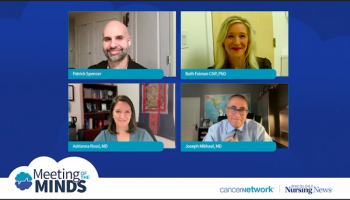
An expert discussion surrounding experience with managing weight gain and gastrointestinal adverse events associated with lorlatinib, addressing quality of life, symptom mitigation strategies, and maintaining treatment efficacy.

An expert discussion surrounding experience with managing weight gain and gastrointestinal adverse events associated with lorlatinib, addressing quality of life, symptom mitigation strategies, and maintaining treatment efficacy.

Key opinion leaders discuss strategies for managing neurotoxicity with lorlatinib and other ALK inhibitors, including monitoring adverse events and balancing symptom management with treatment efficacy.

Key opinion leaders examine approaches to managing skin-related side effects, such as rash, in patients on EGFR inhibitors, highlighting strategies to address quality-of-life impacts while maintaining the benefits of treatment.

Strategies for managing cardiotoxicity in patients on osimertinib are discussed, focusing on monitoring adverse events and balancing symptom management with maintaining treatment efficacy.

Erica S. Doubleday, MS, FNP-C, BSN, RN, outlined upcoming approvals and care options for providers to expect in the breast cancer space.

La-Urshalar Brock, FNP-BC, CNM, RNFA, spoke about the oncology nurse’s and APP’s roles in managing chemotherapy-induced peripheral neuropathy in patients with breast cancer.

Susumu Hijioka, MD, discussed how a lower dose of everolimus may help address certain adverse events like oral mucositis and hypoglycemia.

Panelists discuss how to help patients weigh the risks and benefits of different treatment options for paroxysmal nocturnal hemoglobinuria (PNH), outlining tools and techniques used to ensure that patients and caregivers fully understand their choices and make informed decisions.

Panelists discuss how to help patients weigh the risks and benefits of different treatment options for paroxysmal nocturnal hemoglobinuria (PNH), outlining tools and techniques used to ensure that patients and caregivers fully understand their choices and make informed decisions.

Panelists discuss resources and strategies to help patients and caregivers cope with the initial shock of a paroxysmal nocturnal hemoglobinuria (PNH) diagnosis, emphasizing critical points during the first consultation, and explore how Brandi communicated her treatment preferences to her care team, reflecting on her sense of inclusion in the decision-making process and areas for improvement.

Medical experts discuss strategies for educating patients on managing side effects of osimertinib and other EGFR inhibitors, with guidance on recognizing symptoms that warrant contacting their care team.

Profiling a 58-year-old retired construction manager with Stage IV EGFR+ NSCLC, discussing his transition from osimertinib to amivantamab plus chemotherapy, managing side effects, and maintaining hope throughout his treatment journey.

Medical experts discuss strategies for patient education on managing potential adverse events of lorlatinib and other ALK inhibitors, emphasizing what to expect and when to contact the care team.

A 55-year-old mom and high school teacher who received lorlatinib for ALK+ NSCLC with brain metastases.





Dr. Mikhael and Dr. Rossi discuss the safety profiles of CAR-T therapies for multiple myeloma, focusing on common and impactful adverse events, comparisons between ide-cel and cilta-cel, alignment with clinical trial data, and how safety considerations influence treatment selection for diverse patient populations.

This segment explores the treatment journey of a 55-year-old mother and high school teacher with ALK-positive NSCLC and brain metastases, focusing on her experience with lorlatinib therapy.

Panelists discuss how Brandi first noticed symptoms leading to her paroxysmal nocturnal hemoglobinuria (PNH) diagnosis, highlighting the challenges of the initial diagnostic process, and explore the impact of fatigue and brain fog on her daily life. They also address how clinicians assess the severity of these symptoms during consultations and what they indicate about disease progression or treatment needs.

“You can control where you focus your attention,” said Anne M. Reb, PhD, NP, who recently presented on a nurse-led intervention for patients who experience fear of cancer recurrence.

Patients with breast cancer who are of childbearing age may face issues that are accentuated by their age, an expert explained.

Panelists conclude by discussing the future of graft-versus-host disease management, expressing their hopes for the current treatment landscape and potential advancements that could further improve patient outcomes and quality of life.

Panelists discuss how axatilimab, a novel therapy for chronic graft-versus-host disease (cGVHD), functions through a unique mechanism of action compared to other treatments, highlighting its potential role in cGVHD management and presenting key findings from the AGAVE-201 trial that demonstrate its efficacy and safety profile.

Panelists discuss how the current treatment landscape for chronic graft-versus-host disease includes a range of immunosuppressive approaches, from traditional corticosteroids and calcineurin inhibitors to newer approved agents like axatilimab, ruxolitinib, belumosudil, ibrutinib, and abatacept, emphasizing key considerations patients should be aware of when undergoing these therapies.

Panelists discuss how physician assistants educate and empower chronic graft-versus-host disease patients and their caregivers to recognize, report, and manage symptoms effectively, detailing strategies for patient communication, developing personalized symptom management plans, addressing challenging symptoms, and collaborating with the broader healthcare team to ensure comprehensive care.

Panelists discuss how the care team identifies and manages symptoms in chronic graft-versus-host disease patients, particularly those with advanced disease, emphasizing key symptoms to monitor, approaches to symptom identification, and the critical importance of early detection and management for improving patient outcomes.

Panelists discuss how chronic graft-versus-host disease typically progresses in patients requiring third-line treatment and beyond, focusing on severe symptoms, the impact on quality of life, and potential long-term consequences of inadequately managed symptoms.